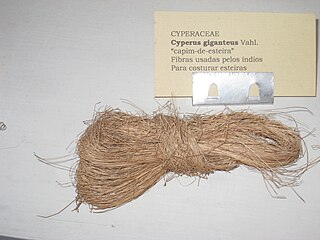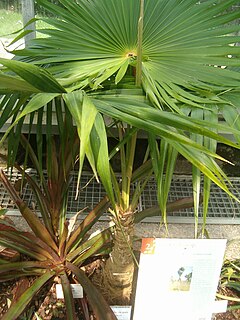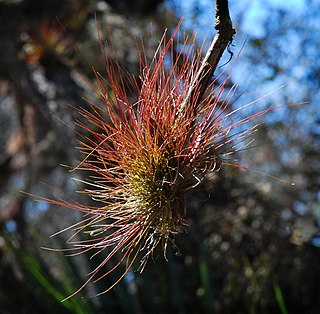Ditta is a genus of plants, under the family Euphorbiaceae first described as a genus in 1861. It is native to the Greater Antilles in the Caribbean.
- Ditta maestrensisBorhidi - Sierra Maestra in SE Cuba
- Ditta myricoidesGriseb. - Cuba, Hispaniola, Puerto Rico

Cyperus giganteus is a perennial herbaceous plant. It belongs to the genus Cyperus. Its native range extends from Jalisco in west-central Mexico as far south as Uruguay, and also grows on some islands in the Caribbean. The species is sparingly naturalized in eastern Texas and southern Louisiana.

Hypoxis decumbens is a species of plant in the Hypoxidaceae, considered by some authors to be included within the Liliaceae or Amaryllidaceae. The species is widespread across South America, Central America, Mexico, and the West Indies.

Coccothrinax alta is a palm which is native to Puerto Rico and the Virgin Islands. Like other members of the genus, C. alta is a fan palm. Trees are 2–6 m tall, with some individuals getting up to 11 m. Flowers are light yellow, and fruit are purple-black when ripe. It is found on lower elevations, but to 350 m above sea level.

Calyptronoma is a genus in the palm family, native to the Greater Antilles. They have pinnately compound leaves with short petioles. The name was coined by August Grisebach who first described the genus in his 1846 Flora of the British West Indian Islands.

Gaussia is a genus in the palm family, native to Mexico, Central America and the Greater Antilles. They are solitary, unarmed, and have pinnately compound leaves. The trees have enlarged bases and prop-roots.

Pseudophoenix is a genus of palms which is native to the wider Caribbean. Three species of the four species are endemic to Hispaniola, while the fourth, P. sargentii, is widely distributed in the northern Caribbean, Florida, and the Yucatán Peninsula.

Prestoea is a genus of palms native to the Caribbean, Central and South America. Its range extends from Nicaragua and the Greater Antilles in the north to Brazil and Bolivia in the south.

Billbergia pyramidalis, commonly known as the flaming torch and foolproof plant, is a species of bromeliad that is native to northern South America and parts of the Caribbean. It was first described by John Sims, and got its current name by John Lindley.

Acrocomia media is a species of palm which is native to Puerto Rico and the Virgin Islands.
Tarigidia is a genus of South African and Puerto Rican plants in the grass family.

Tillandsia bulbosa, the bulbous airplant, is a species in the genus Tillandsia. It is widespread across Central America, the West Indies, southern Mexico, and northern and eastern South America.

Guzmania monostachia is an epiphytic species in the genus Guzmania. Also known as a West Indian tufted airplant, this species is native to South America, Central America, the West Indies and Florida. The species is also reportedly naturalized in Hawaii.
Tillandsia polystachia is a species in the genus Tillandsia. This species is native to Central America, the West Indies, Bolivia, Colombia, Brazil, Ecuador, Mexico and Venezuela.
Catopsis nitida is a species in the genus Catopsis. This species is native to southern Mexico, Central America, Cuba, Hispaniola, Jamaica and Puerto Rico.
Catopsis nutans is a species in the genus Catopsis. This species is native to Florida, Central America, Greater Antilles, Venezuela, Colombia, Bolivia, and Ecuador.

Aechmea lingulata is a plant species in the genus Aechmea. This species is native to the West Indies, Costa Rica, Panama and northern South America.

Tillandsia setacea, the southern needleleaf, is a species in the genus Tillandsia. It has a scattered, disjunct distribution in the southeastern United States, northwestern and southern Mexico, Guatemala, the West Indies and the State of Pará in northeastern Brazil.
Lepanthopsis melanantha, common name tiny orchid, is a very small epiphytic species of orchid. It is native to southern Florida and the Greater Antilles. In Florida, it is known only from the Fahkahatchee Swamp in Collier County.













